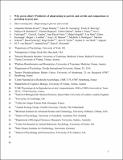Why preen others? Predictors of allopreening in parrots and corvids and comparisons to grooming in great apes
Abstract
Allogrooming in primates serves not only a hygienic function, but also plays a crucial role in maintaining strong affiliative bonds between group members, which in turn, underpin the emergence of cooperative behavior. In contrast, although allopreening occurs in many avian species, we know little about its social functions. Our study addresses this issue by investigating allopreening in a broad comparative data set including six corvid and nine parrot species. We assessed whether rates of allopreening initiations, proportion of time spent allopreening, and the number of grooming partners in captive group‐housed birds were comparable to patterns observed in captive chimpanzees and bonobos. While parrots and corvids were found to have similar rates of social grooming to bonobos and chimpanzees, Pan species dedicated significantly more time to social grooming. Animals in larger groups had more grooming partners, but when controlling for the number of potential partners, birds tended to have fewer grooming interaction partners than Pan species. We then investigated whether allopreening in parrots and corvids was predicted by behavioral markers of affiliative social bonds (close physical proximity, active feeding, and low levels of agonistic behavior). Results revealed that providing allopreening to a partner was significantly predicted by often being in close proximity, but not engagement in active feeding or agonistic behavior. We examined the region allopreened in a subset of species and found that preening a partner's head was predicted by both close physical proximity and active feeding, while body allopreening was only predicted by close physical proximity. Head preening may confer more hygienic benefits to recipients, and thus, may be more selectively provided to valued partners. Results support the hypothesis that allopreening in corvids and parrots helps maintain social bonds with an individual's most important social partners, showing some similarities to allogrooming in primates.
Citation
Picard , A M , Mundry , R , Auersperg , A M , Boeving , E R , Boucherie , P H , Bugnyar , T , Dufour , V , Emery , N J , Federspiel , I G , Gajdon , G K , Guéry , J-P , Hegedič , M , Horn , L , Kavanagh , E , Lambert , M L , Massen , J J M , Rodrigues , M A , Schiestl , M , Schwing , R , Szabo , B , Taylor , A H , van Horik , J O , von Bayern , A M P , Seed , A & Slocombe , K E 2020 , ' Why preen others? Predictors of allopreening in parrots and corvids and comparisons to grooming in great apes ' , Ethology , vol. 126 , no. 2 , pp. 207-228 . https://doi.org/10.1111/eth.12999
Publication
Ethology
Status
Peer reviewed
ISSN
0179-1613Type
Journal article
Collections
Items in the St Andrews Research Repository are protected by copyright, with all rights reserved, unless otherwise indicated.

